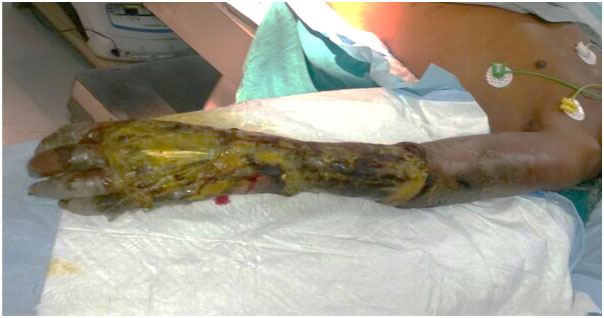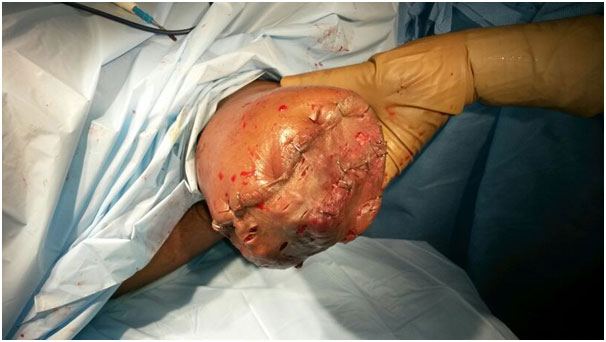Necrotizing Fasciitis of Hand By Methicillin Resistant Staphylococcus aureus (MRSA) – A Sinister
Harendra Chauhan1, Saiprasad Patil2, Anoop Hajare3, K Krishnaprasad4, Amit Bhargava5
1 Consultant, Department of General Medicine, Sterling Hospital, Baroda, India.
2 Assistant Manager, Medical services, Glenmark Pharmaceuticals Ltd, Andheri(E), Mumbai, India.
3 Assistant Manager, Medical services, Glenmark Pharmaceuticals Ltd, Andheri(E), Mumbai India.
4 Deputy General Manager, Medical services, Glenmark Pharmaceuticals Ltd, Andheri(E), Mumbai, India.
5 Vice President, Medical services, Glenmark Pharmaceuticals Ltd, Andheri(E), Mumbai, India.
NAME, ADDRESS, E-MAIL ID OF THE CORRESPONDING AUTHOR: Dr. Saiprasad Patil, Glenmark Pharmaceuticals Ltd, Corporate Enclave, B.D. Sawant Marg, Chakala, Andheri(E), Mumbai - 400099, India. E-mail : saipras300@gmail.com
Necrotizing fasciitis (NF) is an aggressive and life-threatening infection of skin and soft tissue characterized by widespread fascial necrosis, leads to gross morbidity and mortality if left untreated. Although MRSA has become a common isolate associated with skin and soft tissue infections globally over the past few years, monomicrobial MRSA NF has been reported only in a few studies. Our case represents the development of NF followed by trivial trauma salvaged with daptomycin and amputation of the affected limb.
Prompt diagnosis and surgical management with empiric MRSA cover in areas where community acquired MRSA (CA-MRSA) is endemic for suspected cases of necrotizing fasciitis can prevent the dreaded consequences.
Amputation, Daptomycin, Monomicrobial
Case Report
A 58-year-old male clerk working in a Bank at Gujarat, presented to our hospital on 14th December 2013 with swelling of the forearm and discolouration of the skin. He had a fall while playing cricket with his son and sustained superficial bruises along left wrist and forearm 5 days before. He had received some medicines from general practitioner. He had no history of any chronic illnesses like diabetes mellitus or tuberculosis. Patient was well oriented at the time of presentation. Local examination revealed swelling involving left hand and half of left forearm. Blackish discolouration with serosanguineous discharge was present on dorsal aspect of fingers, wrist of left hand.Patient was admitted to ward with suspected clinical diagnosis of necrotizing fasciitis. Debridement of the tissue was undertaken on day one [Table/Fig-1].
Swelling of the fingers along with blackish discolouration and exfoliation of skin of the left hand and forearm

No foul smell was noted. Pus along with deep tissue and blood was sent for culture. Routine laboratory analysis revealed WBC count of 8200/μl.Ceftriaxone plus metronidazole was started empirically. On day 3 of admission patient worsened with 1020F temperature, 38/min respiratory rate, 80/50 mm of Hg blood pressure and pulse rate of 110/min. Serum creatinine was 2.83mg/dl. MRSA sensitive to teicoplanin, clindamycin, vancomycin, linezolid, daptomycin was isolated from debrided sample. D-test was positive. Blood culture also grew MRSA with similar sensitivity. Patient was undertaken for emergency above elbow amputation [Table/Fig-2].
Clean surgical margins post amputation

Patient was put on meropenem 1gm t.i.d and daptomycin 6mg/kg on alternate day. Patient became afebrile on day 3 of daptomycin. He was kept on regular dialysis and on ventilator after surgery. Inotropes and vasopressors started as supportive measure. Subsequent blood culture was negative. Inotropes and vasopressors support weaned off, as urine output was normal. Continued on daptomycin 6mg/kg daily for 15 days. No adverse events were observed. He went home on day 20 of admission.
Discussion
Necrotizing fasciitis (NF) is an aggressive and life-threatening infection of skin and soft tissue characterized by widespread fascial necrosis which can lead to gross morbidity and mortality upto 73% if left untreated [1–3]. NF is usually caused by a mixture of aerobic and anaerobic organisms, typically including group A streptococcus, Enterobacteriaceae, anaerobes, and S. aureus. Although skin and soft tissue infections caused by MRSA is becoming common globally over the past few years, monomicrobial MRSA necrotizing fasciitis reports are sparse in literature [4,5].
Hohendorff B et al., has reported a case of fall at home on left hand leading to fulminant NF of the hand from group A β-haemolytic streptococcus, requiring an lifesaving amputation [6]. Similarly Dias L et al., reported a case of NF of the thumb following minor injury to the left thumb, requiring ICU admission and surgical debridement [7]. Govindan et al., reported a case of NF of lower limb caused by community-associated MRSA salvaged by surgical debridement and linezolid along with broad-spectrum antibiotics [8].
Though experts recommend use of broad-spectrum empirical antimicrobial therapy for suspected cases of necrotizing fasciitis, therapy directed against MRSA is not a standard practice, looking at the rarity of this pathogen as aetiology of NF [5]. Local epidemiology and antibiotic resistance trends determine the applicability of recommendations and guidelines in empirical antibacterial therapy for cSSTI [9].
IDSA 2014 update on practice guidelines for the diagnosis and management of skin and soft tissue infections recommends antimicrobial therapy till patient shows clinical improvement and no further debridement is required. Empiric treatment recommendation for necrotizing fasciitis includes agents effective against both aerobes, including MRSA, and anaerobes [10].
Conclusion
Necrotizing fasciitis caused by community-associated MRSA should be on the radar of treating physician. Prompt diagnosis and surgical management with empiric MRSA cover in areas where community acquired MRSA (CA-MRSA) is endemic for suspected cases of MRSA necrotizing fasciitis can prevent the dreaded consequences. In communities where MRSA infection is becoming endemic, empirical treatment of suspected necrotizing fasciitis or pneumonia should include active MRSA cover.
[1]. Elliott D, Kufera JA, Myers RA, The microbiology of necrotizing soft tissue infectionsAm J Surg 2000 179(5):361-66. [Google Scholar]
[2]. Fontes RA, Ogilvie CM, Miclau T, Necrotizing soft-tissue infectionsJ Am Acad Orthop Surg 2000 8(3):151-58. [Google Scholar]
[3]. Wong CH, Chang HC, Pasupathy S, Khin LW, Tan JL, Low CO, Necrotizing fasciitis: clinical presentation, microbiology, and determinants of mortalityJ Bone Joint Surg Am 2003 85-A(8):1454-60. [Google Scholar]
[4]. Cheng NC, Wang JT, Chang SC, Tai HC, Tang YB, Necrotizing fasciitis caused by Staphylococcus aureus: the emergence of methicillin-resistant strainsAnn Plast Surg 2011 67(6):632-36. [Google Scholar]
[5]. Miller LG, Perdreau-Remington F, Rieg G, Mehdi S, Perlroth J, Bayer AS, Necrotizing fasciitis caused by community-associated methicillin-resistant Staphylococcus aureus in Los AngelesN Engl J Med 2005 352(14):1445-53. [Google Scholar]
[6]. Hohendorff B, Seyler S, Naik M, Biber F, Franke J, Amputation of the Hand due to Necrotising Fasciitis: A Case ReportHandchir Mikrochir Plast Chir 2015 47(1):62-66. [Google Scholar]
[7]. Dias L, Markeson D, Evgeniou E, Misra A, Necrotising fasciitis of the thumbBMJ Case Rep 2012 2012:piibcr2012006380 [Google Scholar]
[8]. Govindan S, Chakrakodi B, Prabhakara S, Arakere G, Kumar S, Bairy I, Necrotizing fasciitis caused by a variant of epidemic methicillin resistant Staphylococcus aureus-15Indian J Med Microbiol. [serial online] 2012 [cited 2015] 30(4):476-79. [Google Scholar]
[9]. Eckmann C, Dryden M, Treatment of complicated skin and soft-tissue infections caused by resistant bacteria: value of linezolid, tigecycline, daptomycin and vancomycinEur J Med Res 2010 15(12):554-63. [Google Scholar]
[10]. Stevens DL, Bisno AL, Chambers HF, Dellinger EP, Goldstein EJC, Gorbach SL, Practice guidelines for the diagnosis and management of skin and soft tissue infections: 2014 update by the Infectious Diseases Society of AmericaClin Infect Dis 2014 59(2):e10-52. [Google Scholar]